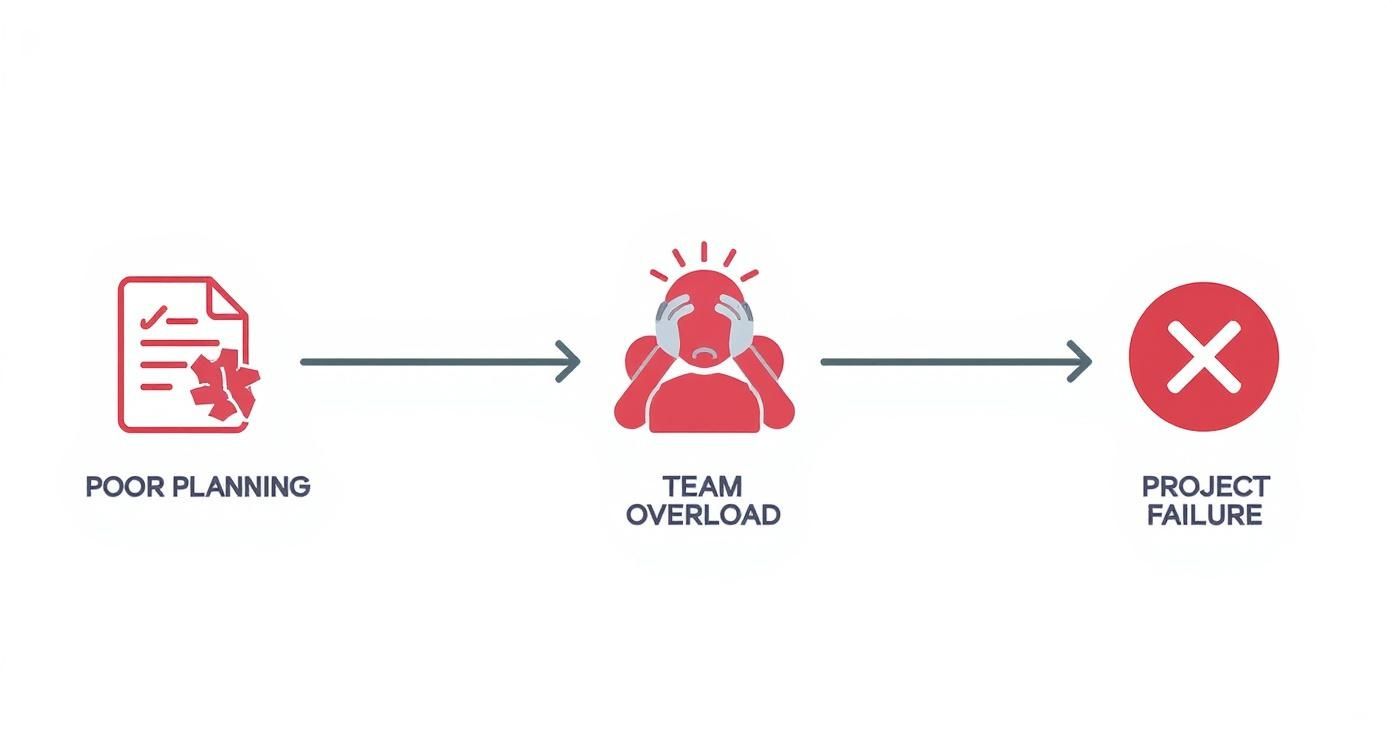Think of resource planning as the master blueprint for your project. It's the strategic process of figuring out exactly what you need—people, tools, budget—and then scheduling and assigning them to get the job done right. The goal is simple: have the right resources, in the right place, at the right time.
This isn't just about avoiding delays; it's about being ruthlessly efficient.
The Blueprint for Successful Projects
Imagine a construction crew trying to build a skyscraper without a blueprint. Chaos, right? You wouldn't know which materials to order, how many workers to hire, or how long each floor should take. The project would be doomed from the start, bleeding money and missing every deadline.
In project management, your resource plan is that essential blueprint. It turns a lofty goal into a step-by-step, achievable plan.
This is way more than just making a to-do list. It requires a deep dive into what—and who—is needed to take a project from a rough idea to a finished product. Getting resource planning project management right is both an art and a science, perfectly aligning your most valuable assets with the project's ultimate objectives.
Core Components of Resource Management
At its core, resource planning is a constant balancing act between three things: scope, time, and cost. You've probably seen this visualized as the classic Project Management Triangle. Each point of the triangle pulls on the others. If you slash the budget, you'll likely need more time or a smaller scope.
This simple diagram shows how scope, time, and cost are all interconnected, with quality sitting right in the middle. Mess with one, and you have to adjust the others to keep quality from suffering.
To pull this off, project managers need to nail a few key areas:
- Resource Identification: Making a comprehensive list of everything you need. This could be the niche skills of a backend developer, specific software licenses for the design phase, or even just physical meeting space.
- Resource Forecasting: Looking ahead to predict what resources you'll need for upcoming projects. This is how you avoid those last-minute scrambles for talent or equipment.
- Resource Allocation: The actual assignment of your available resources to specific tasks on the project timeline.
- Resource Utilization Tracking: Keeping a close eye on how resources are being used compared to the plan. This helps you spot where people are overworked, underused, or where bottlenecks are forming.
Before we dive deeper, let's break down these core elements into a quick-reference table.
Core Components Of Resource Planning
This table summarizes the essential pillars of effective resource planning, giving you a clear overview of what each component involves and why it matters.
| Component | Description | Key Objective |
|---|---|---|
| Identification | Cataloging every person, tool, and budget item needed. | Create a complete inventory of project requirements. |
| Forecasting | Predicting future resource needs based on project pipelines. | Prevent resource shortages and plan for growth. |
| Allocation | Assigning specific resources to tasks and project phases. | Ensure tasks are staffed correctly for timely completion. |
| Utilization | Monitoring how resources are being used in real-time. | Maximize efficiency and prevent burnout or waste. |
Each of these components is crucial. Miss one, and the whole structure can start to feel shaky.
Resource planning isn’t a "set it and forget it" task you do once at the kickoff meeting. It's a living, breathing process. Think of it like a ship's captain constantly adjusting the sails to catch the wind—you have to continuously monitor and tweak the plan to keep the project on course.
This ongoing discipline is what separates projects that thrive from those that just barely survive (or worse, fail). By creating a detailed project management work plan, teams get crystal-clear direction on roles, responsibilities, and deadlines. It’s this structure that helps you sidestep common disasters like team burnout, missed deadlines, and budgets that spiral out of control.
Why Your Projects Fail Without This Strategy
Ever tried to drive cross-country with no map and half a tank of gas? You might start off with a ton of enthusiasm, but you're setting yourself up for a world of hurt. Skipping or rushing through resource planning is pretty much the same thing. Without this foundational strategy, even the most promising projects are likely to stumble into common, yet completely avoidable, pitfalls.
Poor resource planning project management is one of the biggest reasons projects go off the rails. When you don't know who is available, what skills you have on hand, or what the budget can truly support, you're essentially just guessing. This reactive approach is a direct flight to inefficiency and chaos.
It's rarely a single big event that sinks a project. Instead, a lack of planning creates a domino effect. One missed deadline pushes back another, costs start to swell, and before you know it, the entire project is in jeopardy. It’s a crisis built from a series of small, unmanaged issues.
The True Cost of Poor Planning
The damage from neglecting resource planning goes way beyond just missing a deadline or going over budget. The fallout is often deeper and more widespread, hitting everything from team morale to the quality of the final product. The most common symptoms are easy to spot once you know what you’re looking for.
These issues tend to show up in a few predictable ways:
- Scope Creep: Without a clear plan locking down which resources are for which tasks, it’s all too easy for new requests to get tacked on without anyone thinking about the impact. This is how a simple project slowly morphs into an unmanageable monster.
- Constant Firefighting: When project managers don't plan ahead, their days become a frantic rush to put out one fire after another. This leaves zero time for strategic thinking or getting ahead of risks, locking them into a cycle of chaos.
- Team Burnout: It’s a classic mistake: piling all the work onto your top performers. Without a clear view of everyone's workload, you risk burning out your most valuable people. That leads to sloppy work, missed deadlines, and eventually, good employees walking out the door.
These problems don't just put one project at risk; they can slowly poison the effectiveness of your entire team.
A project plan isn't a static document you create and file away. It's your project's immune system, constantly working to identify risks and fight off threats like budget overruns and scope creep before they can do real damage.
This proactive defense is what separates successful projects from the ones that crash and burn. A solid plan ensures every decision is intentional and aligned with the project's goals, not just a panicked reaction to the latest crisis.
How Strategic Planning Creates Success
On the flip side, a project built on solid resource planning runs with precision and clarity. It turns chaos into a predictable workflow, giving the team the space to do their best work. Think of it as the difference between a messy kitchen with ingredients scattered everywhere and a Michelin-star kitchen where every chef knows their station and every ingredient is prepped and ready to go.
When you get resource planning right, the benefits are real and you'll feel them almost immediately.
1. Financial Control and Predictability
A detailed resource plan is your best weapon against budget overruns. By accurately forecasting costs for people, tools, and materials, you set a clear financial baseline from day one. This lets you track spending as it happens and make smart adjustments along the way, keeping the project financially healthy from start to finish. It’s no surprise that studies consistently show projects with mature planning practices are far more likely to hit their budget goals.
2. Enhanced Team Morale and Productivity
Nothing crushes motivation faster than an unfair or impossible workload. Good resource planning project management brings transparency to who is doing what, letting managers spread the work out fairly. This simple act of balancing workloads prevents burnout and builds a collaborative vibe where people feel supported and valued. And when people aren't overworked, their productivity and the quality of their work naturally go up.
3. Proactive Risk Mitigation
A great resource plan does more than just schedule tasks—it helps you see the future. By identifying critical resources and dependencies early, you can spot potential bottlenecks long before they become a problem. This foresight allows you to build contingency plans, like cross-training team members or having backup equipment on standby. Suddenly, a potential crisis becomes nothing more than a minor hiccup.
A Step-By-Step Guide to Resource Planning
Moving from the theory of resource planning to a practical, repeatable process is where the magic really happens in project management. A structured approach isn't about rigid rules; it’s about having a flexible framework you can apply to any project, no matter how big or small. It’s the difference between guessing and knowing.
This guide breaks down the core phases of resource planning project management into a series of clear, manageable actions.
The infographic below shows a pretty direct line from poor planning to project failure. It’s a stark reminder that skipping these early steps almost always leads to an overloaded team and a project that goes off the rails.
As you can see, project failure is rarely a big surprise. It's usually the predictable outcome of a process that started with shaky planning.
Step 1: Define the Project Scope and Objectives
Before you can even think about what resources you need, you have to know—with total clarity—what you're trying to build. This first step is all about defining the project’s goals, deliverables, and, just as importantly, its boundaries.
Get your key stakeholders in a room (or on a call) and hammer out a clear scope statement. This document needs to answer a few critical questions:
- What are the specific, measurable goals of this project?
- What are the key deliverables we'll produce and the milestones we'll hit?
- What is officially "out of scope" for this project?
A well-defined scope is your North Star. It’s what keeps the dreaded scope creep from pulling your timeline and budget completely off course down the road.
Step 2: Identify All Necessary Resources
With a solid scope in hand, it's time to take inventory. And I mean everything. This goes way beyond just listing out your team members. A truly comprehensive resource list covers several key areas.
- Human Resources: Don't just list job titles; think about the actual skills required. Do you need a general front-end developer, or do you need someone who’s an expert in a specific framework? Is a standard graphic designer enough, or do you need someone who specializes in video animation?
- Equipment and Tools: This includes everything from physical machinery and software licenses to specific testing environments and the platforms your team uses to communicate.
- Facilities: Do you need dedicated meeting rooms, extra office space, or maybe a specialized workshop for a portion of the project?
- Budget: Money is the fuel that makes the project run. Get a detailed budget outlined and, most importantly, approved.
Think of this as a pre-flight check. It ensures you don’t find yourself scrambling for a critical tool or person at the last minute.
Step 3: Forecast Demand and Assess Availability
Okay, so you know what you need. Now you have to figure out when you need it and who is actually free to do the work. This is all about mapping your resource needs to the project timeline.
Forecasting is about looking ahead. For example, your UX designer might be needed full-time for the first two weeks, but maybe only a few hours a week once development kicks into high gear. You then have to check that demand against your team's real-world availability—factoring in their other projects, holidays, and any planned time off.
This is where so many plans fall apart. The single biggest mistake is assuming a team member is 100% available for your project. Great forecasting accepts the reality that people are almost always juggling multiple commitments.
Step 4: Allocate Resources and Assign Tasks
This is where the plan starts to feel real. Resource allocation is the act of officially assigning your people, tools, and budget to specific tasks on the project schedule. But it's more than just dropping names into a spreadsheet; it’s about making smart, strategic decisions.
For instance, you'd likely assign your most senior engineer to the riskiest, most complex piece of code to minimize potential problems. This is also the stage where you might use techniques like resource leveling—adjusting the schedule a bit to smooth out workloads and prevent burnout, even if it means the timeline stretches slightly.
This is the perfect time to get a clear, visual handle on everyone's workload. If you're looking for a simple way to start, a pre-built capacity planning template for Excel can give you the clarity you need to avoid overbooking your most important people.
Step 5: Track and Monitor Utilization Continuously
Resource planning isn't a "set it and forget it" activity. It's a living, breathing process. As soon as the project kicks off, your job shifts to monitoring how your actual resource usage stacks up against your plan.
Are certain tasks taking way longer than you estimated? Is one of your team members sitting idle while another is completely swamped?
By tracking these things regularly, you can make smart adjustments on the fly. When a bottleneck appears, you can shift resources to clear it. If someone wraps up their work early, you can pull a future task forward to keep the momentum going. This active, ongoing monitoring is what ultimately keeps a project on track, on time, and on budget.
Navigating the Toughest Project Management Challenge
Let’s be honest: resource planning in project management is tough. Really tough. If you feel like you're constantly juggling team availability, shifting deadlines, and last-minute scope changes, you're not alone. This process is consistently ranked as one of the most draining parts of being a project manager.
The real headache is its dynamic nature. A resource plan isn't some document you create once and frame on the wall. It’s a living battlefield where your perfect plan meets the messy reality of actually getting work done. Just when you think everything is lined up, a key developer gets poached for a "higher-priority" task, the client has a sudden change of heart, or an estimate proves to be a work of pure fiction.
This constant state of flux is exactly why real-time tracking is so crucial. Without a clear picture of who is working on what right now, managers are left making calls based on old news. That’s a fast track to bottlenecks and burning out your best people.
Why Is Resource Planning So Hard?
The difficulty goes way beyond simple logistics. It’s about managing a tangled web of variables where a single change can set off a domino effect across multiple projects, especially if you’re all sharing the same pool of people. This is how teams get stuck in a reactive loop, constantly putting out fires instead of preventing them.
Here are a few of the usual suspects:
- Inaccurate Estimations: It happens all the time. Teams underestimate how long a task will take, and suddenly the whole resource forecast is off. This is a huge problem for complex or innovative projects where you don’t have much historical data to lean on.
- Shifting Project Priorities: In any busy company, priorities can change on a dime. The resource you were banking on might get pulled for a more urgent initiative, putting your entire timeline at risk.
- Managing Shared Resources: When your team members are split across different projects, their availability becomes a complex puzzle. Figuring out their true capacity and avoiding overload requires non-stop communication and careful oversight.
- Lack of Visibility: Without a central system, getting an accurate, real-time view of who’s doing what is nearly impossible. Managers are left guessing who’s slammed and who has room for more, which almost always leads to inefficient work assignments.
Getting past these hurdles isn’t about building a better spreadsheet. It requires a fundamental shift in how we approach projects.
The Rise of Adaptive Planning and Modern Tools
The old-school, rigid ways of managing projects are just too brittle for today's world. This has pushed more and more teams toward flexible, hybrid approaches that mix the structure of traditional planning with the adaptability of agile. This isn't just a trend; it's a necessary evolution.
Resource management is frequently cited as the most difficult part of project management, demanding continuous tracking of utilization at every level—from individual workloads to the entire project portfolio.
This is precisely why specialized software has become a non-negotiable for high-performing teams. In fact, studies show that around 77% of successful projects credit their outcomes to using project management software for better coordination. As organizations catch on, the data is clear: 73% expect to increase their use of hybrid project management methods in the next five years, signaling a huge move toward more responsive and resilient planning. You can dig into more of these project management statistics and future trends to see where things are headed.
Modern tools give you the critical visibility needed to spot conflicts before they blow up. They let managers track utilization in real time, run "what-if" scenarios to see the impact of changes, and make smart, data-driven decisions on the fly. By embracing adaptive planning powered by the right technology, teams can finally stop reacting to problems and start strategically navigating the challenges of resource planning in project management.
Best Practices For Superior Resource Management
Knowing the steps of resource planning is one thing, but truly mastering it is another game entirely. To get there, you need to graduate from simply filling out a schedule to building a strategic, transparent, and adaptive system for managing your most valuable assets—your people.
The goal is to move away from a reactive, "set it and forget it" approach. Instead, think of it as continuous optimization. Great resource management isn't just about dodging bullets; it’s about creating an environment where both your projects and your people can truly excel.
Foster A Culture Of Transparency
The best resource plans are built on a bedrock of open communication. When everyone can see who’s working on what and when, it cuts out the guesswork and stops resource conflicts before they even have a chance to start.
This level of transparency builds trust. It also empowers your team members to raise a flag when they spot a potential roadblock, which is invaluable. A centralized resource pool is the cornerstone here. Instead of walling off talent within specific departments, a shared pool gives managers a bird's-eye view of who’s available and what skills they bring to the table.
Develop A Comprehensive Skills Inventory
Knowing someone’s job title is barely scratching the surface in modern resource planning project management. A "senior developer" could be a backend wizard or a front-end genius—two completely different skill sets. That’s where a skills inventory comes in.
Think of it as a detailed database that goes beyond titles to track the specific skills, certifications, and experience levels of everyone on your team.
This inventory lets you:
- Match Skills to Tasks with Precision: You can find the exact right person for a highly specialized job, which boosts both quality and speed.
- Identify Critical Skill Gaps: It becomes immediately obvious where your team is lacking expertise, so you can plan for hiring or training.
- Support Employee Growth: You can spot opportunities for team members to stretch their abilities and learn new skills on upcoming projects.
Embrace Continuous Monitoring And Adjustment
A resource plan isn't a stone tablet; it's a living, breathing document. The most successful project managers treat it that way, constantly checking in on utilization rates and making adjustments on the fly. Are certain tasks taking way longer than you thought? Is one of your team members consistently light on work?
Reviewing your plan regularly allows you to reallocate resources, shift timelines, and clear up bottlenecks before they can throw the whole project off track. This agile mindset is absolutely essential for dealing with the curveballs that every project inevitably throws.
True capacity planning isn't just about scheduling work; it's about protecting your team's well-being. By actively preventing over-allocation, you build a sustainable pace that avoids burnout and keeps your best talent engaged and productive.
This kind of proactive oversight is also crucial for smart, strategic growth. When you have a firm grasp of your team's current capacity, you can make much better decisions about which new projects to take on. You can explore these strategies further in our guide on workforce planning best practices.
Plan For The Future Talent Gap
Solid resource planning isn't just about the here and now; it's a critical piece of your organization's long-term health. This is especially true given the massive talent shortage looming over the industry.
By 2035, the global project management field is expected to face a demand gap of up to 30 million professionals. That’s a staggering number, and it underscores just how urgent it is for companies to start developing and holding onto qualified project managers. You can see more on this in these insightful project management statistics for 2025. By identifying skill gaps today, you can build targeted talent development programs that get your team ready for whatever comes next.
Resource Planning Practices Poor vs Best
To really drive home the difference between just doing resource planning and excelling at it, let's compare some common pitfalls with the best practices that lead to success. The contrast is pretty stark.
| Area | Poor Practice (To Avoid) | Best Practice (To Implement) |
|---|---|---|
| Visibility | Siloing resources within departments, leading to hidden talent and scheduling conflicts. | Creating a centralized, transparent resource pool accessible to all project managers. |
| Skill Matching | Assigning tasks based on job titles or general availability, risking a mismatch. | Using a detailed skills inventory to match the right person to the right task with precision. |
| Planning Approach | Creating a static plan at the start and rarely updating it ("set it and forget it"). | Treating the plan as a living document with continuous monitoring and real-time adjustments. |
| Team Well-being | Consistently overallocating team members, leading to burnout and high turnover. | Proactively monitoring utilization to ensure a sustainable workload and prevent burnout. |
| Future Focus | Reacting to skill gaps only when they become urgent problems for a current project. | Using insights from current projects to forecast future needs and plan for talent development. |
Adopting the practices on the right side of this table is what separates the teams that merely survive from the ones that consistently thrive. It’s a shift from being reactive to being strategic, and it makes all the difference.
Still Have Questions About Resource Planning?
Even with a perfect plan on paper, questions always pop up in the real world of managing projects. Let's tackle some of the most common ones that project managers run into.
What Is the First Step in Resource Planning?
Before you can assign a single person or budget a single dollar, you need to know exactly what you’re building. The very first step, without question, is to define the project scope and deliverables with crystal clarity.
This isn't just a vague idea; it means creating a detailed Work Breakdown Structure (WBS). Breaking the project down into smaller, bite-sized tasks is the only reliable way to figure out what—and who—you’ll need from the get-go.
How Do You Handle Unexpected Resource Shortages?
When a key person calls in sick or a critical piece of equipment fails, you need a plan. Handling unexpected shortages is a two-pronged attack: be proactive before it happens and reactive when it does.
The proactive part is simple: build a little buffer into your schedule for contingencies. But when a shortage actually hits, it's time to react. You have to re-prioritize immediately. Can a less critical task be pushed back to free someone up? Does another team member have the skills to pinch-hit? The most important thing is to communicate the impact to stakeholders right away and show them your revised game plan.
Resource allocation is about assigning your team to tasks. Resource leveling is what you do after that to fix overloads and prevent burnout, even if it means adjusting the timeline.
What Is the Difference Between Allocation and Leveling?
It’s easy to mix these two up, but they happen at different stages.
Think of resource allocation like picking your starting lineup for a game. You’re assigning your available people, budget, and tools to specific tasks. It’s the initial "who does what" phase of the plan.
Resource leveling, on the other hand, is the coaching strategy you use mid-game to make sure your star player doesn’t get exhausted. It's a technique for adjusting schedules and timelines to smooth out the workload. You might shuffle start dates to resolve conflicts, ensuring no one is double-booked and the pace is sustainable for the long haul.
Which Tools Are Best for Resource Planning?
Honestly, the "best" tool completely depends on your team's size and how complex your projects are. If you're a tiny team working on one simple thing, you might get by with a well-organized spreadsheet.
But for most teams juggling multiple projects, that's just not going to cut it. Dedicated software is pretty much a necessity. Tools like Asana, Monday.com, or Jira give you the real-time visibility and collaboration features you need to manage everything without losing your mind.
Ready to stop guessing and start seeing your team's real capacity? TimeTackle provides AI-powered insights from your existing calendars, giving you the clarity needed for smarter resource planning and improved project outcomes. Discover how to optimize your team's time at https://www.timetackle.com.






